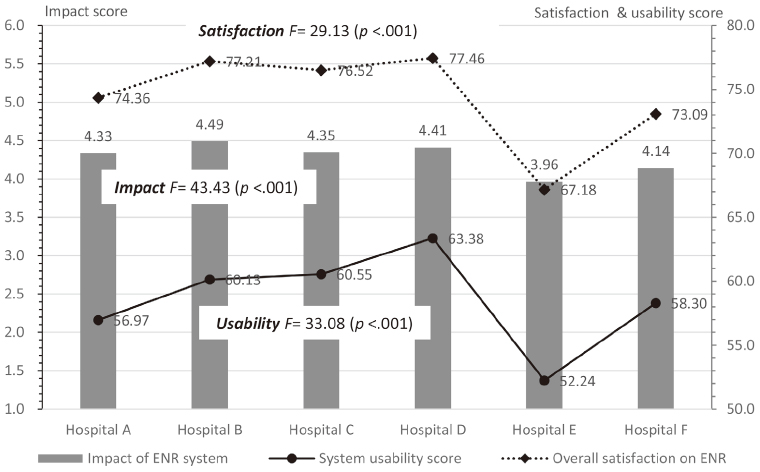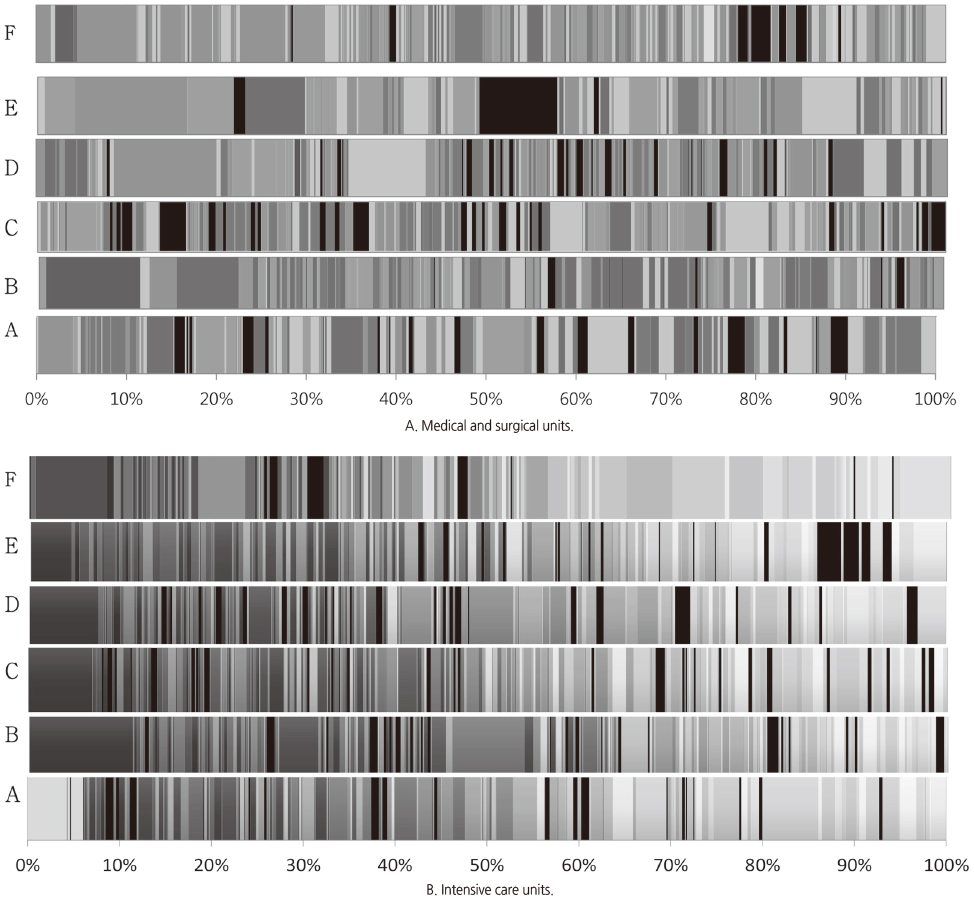J Korean Acad Nurs.
2015 Aug;45(4):523-532. 10.4040/jkan.2015.45.4.523.
Identifying Usability Level and Factors Affecting Electronic Nursing Record Systems: A Multi-institutional Time-motion Approach
- Affiliations
-
- 1Department of Nursing, Inha University, Incheon, Korea. insook.cho@inha.ac.kr
- 2Department of Nursing, SMG-SNU Boramae Medical Center, Seoul, Korea.
- 3Department of Nursing, Seoul National University Hospital, Seoul, Korea.
- 4Department of Nursing, Dongguk University Ilsan Hospital, Goyang, Korea.
- 5Department of Nursing, Ajou University Hospital, Suwon, Korea.
- 6Department of Nursing, Korea University Guro Hospital, Seoul, Korea.
- 7Department of Nursing, Pai Chai University, Daejeon, Korea.
- 8Department of Nursing, National Cancer Center, Goyang, Korea.
- KMID: 2164393
- DOI: http://doi.org/10.4040/jkan.2015.45.4.523
Abstract
- PURPOSE
The usability, user satisfaction, and impact of electronic nursing record (ENR) systems were investigated.
METHODS
This mixed-method research was performed as a time-motion (TM) study and a survey which were carried out at six hospitals between August and November 2013. The TM study involved 108 nurses from medical, surgical, and intensive care units at each hospital, plus an additional 48 nurses who served as nonparticipating observers. In the survey, 1879 volunteer nurses completed the Impact of ENR Systems Scale, the System Usability Scale, and a global satisfaction scale. Qualitative and quantitative analyses were performed.
RESULTS
The mean scores for the ENR impact, system usability, and satisfaction were 4.28 (out of 6), 58.62 (out of 100), and 74.31 (out of 100), respectively, and they differed significantly between hospitals (F=43.43, p<.001, F=53.08 and p<.001, and F=29.13 and p<.001, respectively). A workflow fragmentation assessment revealed different patterns of ENR system use among the included hospitals. Three user characteristics-educational background, practice period, and experience of using paper records-significantly affected the system usability and satisfaction scores.
CONCLUSION
The system quality varied widely among the ENR systems. The generally low-to-moderate levels of system usability and user satisfaction suggest many opportunities for improvement.
Keyword
MeSH Terms
Figure
Reference
-
1. Zhou L, Soran CS, Jenter CA, Volk LA, Orav EJ, Bates DW, et al. The relationship between electronic health record use and quality of care over time. J Am Med Inform Assoc. 2009; 16(4):457–464. DOI: 10.1197/jamia.M3128.2. Krist AH, Beasley JW, Crosson JC, Kibbe DC, Klinkman MS, Lehmann CU, et al. Electronic health record functionality needed to better support primary care. J Am Med Inform Assoc. 2014; 21(5):764–771. DOI: 10.1136/amiajnl-2013-002229.3. Schumacher RM, Lowry SZ. NIST guide to the processes approach for improving the usability of electronic health records. Gaithersburg, MD: National Institute of Standards and Technology;2010. 11. Report No.: NISTIR 7741.4. Middleton B, Bloomrosen M, Dente MA, Hashmat B, Koppel R, Overhage JM, et al. Enhancing patient safety and quality of care by improving the usability of electronic health record systems: Recommendations from AMIA. J Am Med Inform Assoc. 2013; 20(e1):e2–e8. DOI: 10.1136/amiajnl-2012-001458.5. Stevenson JE, Nilsson GC, Petersson GI, Johansson PE. Nurses' experience of using electronic patient records in everyday practice in acute/inpatient ward settings: A literature review. Health Informatics J. 2010; 16(1):63–72. DOI: 10.1177/1460458209345901.6. Cho I, Choi WJ, Choi WH, Kim MK. The adoptions and use of electronic nursing records in Korean hospitals: Findings of a nationwide survey. J Korean Clin Nurs Res. 2013; 19(3):345–356.7. Zheng K, Guo MH, Hanauer DA. Using the time and motion method to study clinical work processes and workflow: Methodological inconsistencies and a call for standardized research. J Am Med Inform Assoc. 2011; 18(5):704–710. DOI: 10.1136/amiajnl-2011-000083.8. International Organization for Standardization, International Electrotechnical Commission. Ergonomic requirements for office work with visual display terminals (VDTs) - Part 14: Menu dialogues [Internet]. Geneva, CH: Author;1997. cited 2014 November 1. Available from: https://www.iso.org/obp/ui/#iso:std:16886:en.9. Dykes PC, Hurley A, Cashen M, Bakken S, Duffy ME. Development and psychometric evaluation of the impact of health information technology (I-HIT) scale. J Am Med Inform Assoc. 2007; 14(4):507–514. DOI: 10.1197/jamia.M2367.10. Zhang J, Walji MF. TURF: Toward a unified framework of EHR usability. J Biomed Inform. 2011; 44(6):1056–1067. DOI: 10.1016/j.jbi.2011.08.005.11. DesRoches CM, Miralles P, Buerhaus P, Hess R, Donelan K. Health information technology in the workplace: Findings from a 2010 national survey of registered nurses. J Nurs Adm. 2011; 41(9):357–364. DOI: 10.1097/NNA.0b013e31822a7165.12. Brooke J. SUS: A quick and dirty usability scale. In : Jordan PW, Thomas B, Weerdmeester BA, McClelland IL, editors. Usability evaluation in industry. London, UK: Taylor & Francis;1996. p. 189–194.13. Agency for Healthcare Research and Quality. Time and motion study tool: Ambulatory practice (TMS-AP) [Internet]. Rockville, MD: Author;2007. cited 2014 November 1. Available from: http://healthit.ahrq.gov/sites/default/files/docs/page/AHRQ%20NRC%20Time-Motion%20Study%20Tool%20Guide_0.pdf.14. Song KJ, Kim EH, Yoo CS, Park HO, Park KO. Development of KPCS (Korean patient classification system for nurses) based on nursing needs. J Korean Clin Nurs Res. 2009; 15(1):5–17.15. Choi WH, Park IS, Shin HJ, Joo YH, Kim YA, Jung EH, et al. Comparison of direct and indirect nursing-care times between physician order entry system and electronic medical records. Stud Health Technol Inform. 2006; 122:288–293.16. Bangor A, Kortum P, Miller J. Determining what individual SUS scores mean: Adding an adjective rating scale. J Usability Stud. 2009; 4(3):114–123.17. Carrington JM, Effken JA. Strengths and limitations of the electronic health record for documenting clinical events. Comput Inform Nurs. 2011; 29(6):360–367. DOI: 10.1097/NCN.0b013e3181fc4139.18. Trafton J, Martins S, Michel M, Lewis E, Wang D, Combs A, et al. Evaluation of the acceptability and usability of a decision support system to encourage safe and effective use of opioid therapy for chronic, noncancer pain by primary care providers. Pain Med. 2010; 11(4):575–585. DOI: 10.1111/j.1526-4637.2010.00818.x.19. Kim MS, Shapiro JS, Genes N, Aguilar MV, Mohrer D, Baumlin K, et al. A pilot study on usability analysis of emergency department information system by nurses. Appl Clin Inform. 2012; 3(1):135–153. DOI: 10.4338/aci-2011-11-ra-0065.20. Jung JH, Myung GH, Kang KH, Park EH. Analysis of standard nursing statements recorded in an electronic nursing record system and user satisfaction. Perspect Nurs Sci. 2012; 9(2):146–153.21. Shin A, Park HJ, Jung SJ, Park MH, Yoon KI, Kim YN. Analysis survey of user satisfaction with electronic nursing record system in a general hospital in Daegu. J Korean Soc Health Inf Health Stat. 2009; 34(1):29–39.22. DesRoches CM, Campbell EG, Rao SR, Donelan K, Ferris TG, Jha A, et al. Electronic health records in ambulatory care-a national survey of physicians. N Engl J Med. 2008; 359(1):50–60. DOI: 10.1056/NEJMsa0802005.23. Hendrich A, Chow MP, Skierczynski BA, Lu Z. A 36-hospital time and motion study: How do medical-surgical nurses spend their time? Perm J. 2008; 12(3):25–34.24. Yee T, Needleman J, Pearson M, Parkerton P, Parkerton M, Wolstein J. The influence of integrated electronic medical records and computerized nursing notes on nurses' time spent in documentation. Comput Inform Nurs. 2012; 30(6):287–292. DOI: 10.1097/NXN.0b013e31824af835.25. Kim DY, Park MH. Intermediate evaluation after the introduction of electronic nursing record system in a general hospital. J Korean Clin Nurs Res. 2010; 16(3):133–144.26. Allen B. Knowledge organization in an information retrieval task. Inf Process Manag. 1990; 26(4):535–542. DOI: 10.1016/0306-4573(90)90073-B.27. Allen B. Cognitive abilities and information system usability. Inf Process Manag. 1994; 30(2):177–191. DOI: 10.1016/0306-4573(94)90063-9.
- Full Text Links
- Actions
-
Cited
- CITED
-
- Close
- Share
- Similar articles
-
- Usability of Academic Electronic Medical Record Application for Nursing Students' Clinical Practicum
- Nurses’ Experiences with the Use of Electronic Nursing Record: A Qualitative Study
- Human Factors Engineering in HI: So What? Who Cares? and What's in It for You?
- Comparison of Nursing Records of Open Heart Surgery Patients before and after Implementation of Electronic Nursing Record
- Needs Assessment for Functionalities in Electronic Health Record Systems in General Hospitals




